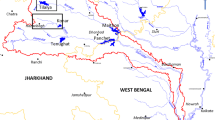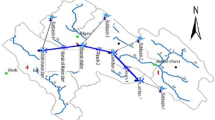Abstract
The capability of ANN to generate synthetic series of river discharge averaged over different time steps with limited data has been investigated in the present study. While an ANN model with certain input parameters can generate a monthly averaged streamflow series efficiently; it fails to generate a series of smaller time steps with the same accuracy. The scope of improving efficiency of ANN in generating synthetic streamflow by using different combinations of input data has been analyzed. The developed models have been assessed through their application in the river Subansiri in India. Efficiency of the ANN models has been evaluated by comparing ANN generated series with the historical series and the series generated by Thomas-Fiering model on the basis of three statistical parameters-periodical mean, periodical standard deviation and skewness of the series. The results reveal that the periodical mean of the series generated by both Thomas–Fiering and ANN models are in good agreement with that of the historical series. However, periodical standard deviation and skewness coefficient of the series generated by Thomas–Fiering model is inferior to that of the series generated by ANN.














Similar content being viewed by others
Abbreviations
- p :
-
period which may be 10 days or month t year
- q av,p :
-
mean of the historical streamflow series for period p(current period t)
- q av,p+1 :
-
mean of the historical streamflow series for period p + 1(next period)
- σ p :
-
standard deviation of historical series of period p
- σ p+1 :
-
standard deviation of historical series of period p + 1 respectively
- r p,p+1 :
-
correlation between period p and p + 1 of historical series
- ξ p,t :
-
independent standard normal random variable
- q p,t :
-
two dimensional array in which p represents period i.e. January, February,……, December while t represents for year in which t = 1 means for first year and so on.
- q p+1,t :
-
logarithmic discharge which has generated for period p + 1int th year
- y j (t) :
-
standardized target value for pattern j, y j = output response from the network for pattern j
- p :
-
total number of training pattern
- q :
-
number of output nodes
- α:
-
momentum factor
- η:
-
learning rate
- p n :
-
normalized input
- p a :
-
actual input
- min p :
-
minimum value of input vector
- max p :
-
maximum value of the input vector
- I t :
-
streamflow of current period
- I t-1 :
-
streamflow of previous period
- μt+1 :
-
mean of historical streamflow of next period
- σ t+1 :
-
standard deviation of historical streamflow of next period
- min t+1 :
-
minimum value of inflow from the given historical record
- max t+1 :
-
maximum value of inflow from the given historical record
- G t+1 :
-
average time rate of change of discharge of the series
References
Ahmed JA, Sarma AK (2007) Artificial neural network model for synthetic streamflow generation. Water Resour Manag 21(6):1015–1029
Bayazıt M (1988) Hidrolojik Modeller. İ.T.Ü. rektörlüğü, İstanbul
Bilhan O et al. (2010) Application of two different neural network techniques to lateral outflow over rectangular side weirs located on a straight channel. Adv Eng Softw 4:831–837
Birikundavyi S, Labib R, Trung H, Rousselle J (2002) Performance of neural networks in daily streamflow forecasting. J Hydrol Eng 7(5):392–398
Box GEP, Cox DR (1964) An analysis of transformations. J R Stat Soc–Ser B 26(2):211–252
Box GEP, Jenkins GM (1976) Time series analysis forecasting and control. Holden-Day, San Francisco
Burian JS, Durrans SR, Nix SJ, Pitt RE (2001) Training artificial neural networks to perform rainfall disaggregation. J Hydrol Eng 6(1):43–51
Chandramouli V, Raman H (2001) Multireservoir modeling with dynamic programming and neural networks. J Water Resour Plan Manag 127(2):89–98
Chandramouli V, Deka P (2005) Neural network based decision support model for optimal reservoir operation. Water Resour Manag 19:447–464
Diamantopoulou JM, Antonopoulos VZ, Papamichail DM (2007) Cascade correlation artificial neural networks for estimating missing monthly values of water quality parameters in rivers. Water Resour Manag 21:649–662
Emiroglu ME, Bilhan O, Kisi O (2011) Neural networks for estimation of discharge capacity of triangular labyrinth side-weir located on a straight channel. Expert Systems with Applications 38:867–874
Govindaraju RS, Rao AR (2000) Artificial neural networks in hydrology. Kluwer Academic Publishers, Dordrecht
Hagan MT, Demuth HB, Beale M (1996) Neural network design. PWS/KENT Publishing Co., Boston
Karunanithi N, Grenney WJ, Whitley D, Bovee K (1994) Neural networks for river flow prediction. J Comput Civ Eng 8(2):201–220
Kisi O (2007) Streamflow forecasting using different artificial neural network algorithms. J Hydrol Eng 12(5):532–539
Kisi O (2008) Stream flow forecasting using neuro-wavelet technique. Hydrol Process 22:4142–4152
Kisi O (2009) Neural networks and wavelet conjunction model for intermittent streamflow forecasting. J Hydrol Eng 14(8):773–782
Kumar D, Raju K, Sathish T (2004) River flow forecasting using recurrent neural networks. Water Resour Manag 18:143–161
Maass A, Hufschmidt MM, Dorfman JR, Thomas HA, Marglin SA, Fair GM (1970) Design of water resources systems. Harvard University Press, Cambridge
Ochoa-Rivera JC, Andreu J, García-Bartual R (2007) Influence of inflows modeling on management simulation of water resources system. J Water Resour Plan Manag 2:106–116
Raman H, Sunilkumar N (1995) Multivariate modeling of water resources time series using artificial neural networks. J Hydrol Sci 40(2):145–163
Rumelhart DE, Hinton GE, Williams RJ (1986) Learning internal representations by error propagation. In: Rumelhart DE and McCleland JL (ed) Parallel distributed processing, MIT Press, Cambridge, Mass, 1, pp318–362
Ray M (2010) Optimal operation of the reservoir considering downstream impact of the hydroelectric project. Ph.D, Dissertation Indian Institute of Technology Guwahati, India
Shiri J, Kisi O (2010) Short-term and long-term streamflow forecasting using a wavelet and neuro-fuzzy conjunction model. J Hydrol 394:486–493
Shiau JT, Hsu HT (2016) Suitability of ANN-based daily streamflow extension models: a case study of Gaoping River Basin, Taiwan. Water Resour Manag 30(4):1499–1513
Srinivasulu S, Jain A (2006) A comparative analysis of training methods for artificial neural network rainfall–runoff models. Appl Soft Comput 6:295–306
Stedinger JR, Taylor MR (1982) Synthetic streamflow generation 1: Model verification and validation. Water Resour Res 18(4):909–918
Thomas HA, Fiering MB (1962) Mathematical synthesis of streamflow sequences for the analysis of river basins by simulation. In: Maas A et al. (eds) Design of Water Resources Systems. Harvard University Press, Cambridge, Mass
Treiber B, Schultz GA (1976) Comparison of required reservoir storages computed by the Thomas-Fiering model and the 'Karlsruhe model' Type A and B. Hydrol Sci-Bull-des Sci Hydrol-XXI 1(3):177–185
Salas JD, Delleur JW, Yevjevich V, Lane WL (1980) Applied modeling of hydrologic time series. Water Resources Publications, Littleton, Colo
Wen CG, Lee CS (1998) A neural network approach to multiobjective optimization for water quality management in a river basin. Water Resour Res 34(3):427–436
Yurekli K, Kurunc A (2004) Performances of stochastic approaches in generating low streamflow data for drought analysis. J Spat Hydrol 5(1):20–32
Zealand CM, Burn DH, Simonovic SP (1999) Short term streamflow forecasting using artificial neural networks. J Hydrol 214:32–48
Author information
Authors and Affiliations
Corresponding author
Rights and permissions
About this article
Cite this article
Ray, M.R., Sarma, A.K. Influence of Time Discretization and Input Parameter on the ANN Based Synthetic Streamflow Generation. Water Resour Manage 30, 4695–4711 (2016). https://doi.org/10.1007/s11269-016-1448-x
Received:
Accepted:
Published:
Issue Date:
DOI: https://doi.org/10.1007/s11269-016-1448-x




